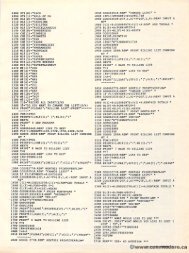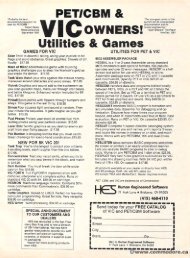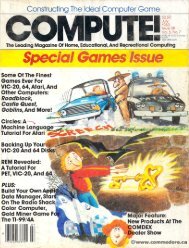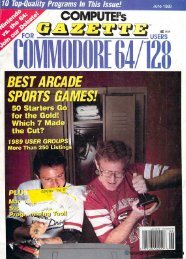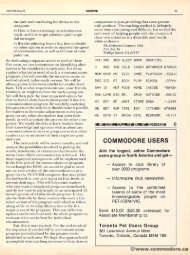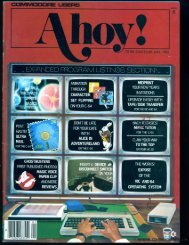You also want an ePaper? Increase the reach of your titles
YUMPU automatically turns print PDFs into web optimized ePapers that Google loves.
170 COM PUTEI Moy.1982. lssue 2A<br />
170 COMPUTE! May. 1982. Issue 24<br />
For people who would find il it Vel)' very difficult to enter comlllands commands or use the neyboaul, keyboard, the program below prints jJrinls<br />
messa.ges (or BASI C commands) 011 screen and allows (h e user 10 movp (l jJoinll'r (0 Ihe desiTed w OH/lIlId (' Iller it<br />
messages (or BASIC, commands) on screen and allows the user to move a pointer to the desired word and enter it<br />
into Ih(1 the (um/Jllft' computer. l'. It II rail can (lea/Jt accept ill/JIII input from jtorn either the I/ul I1ll1llt'r;r numeric keypad }{(7 /xJ(1 nrfrom orfrom a joystick. It II is t/('Siglll'{/ designed Io to worh work 011 on a<br />
PET willi with 1111' the Gm/Jllin Graphics keyboard, III')'boflrt!, blll but ille the cell/r{d central idea could be arlfl/JINI adapted to any filly colI/./JlIler.<br />
computer.<br />
Handicapped Programming<br />
Hilton B. Souther<br />
Lynchburg. Lynchburg, VA<br />
This program allows a person lO to build messages on<br />
the screen or could even be used lO program. The<br />
the screen or could even be used to program. The<br />
input is made by pressing a button on ajoystick a or<br />
by pressing g keyboard numeric pad no. 5.<br />
When the program first comes conies up, it gives you<br />
an option of moving a pointer with the numeric<br />
an option or moving a pointe r with the nume ric<br />
pad orr using the jjoystick; from then on, it responds<br />
based on the input. The program is set up li p for the<br />
joystick on the hi gh order bits on the user port. I I'<br />
joystick on the high order bits on the user port. If<br />
there is no joystick, all commands come from the<br />
numeric pad.<br />
Most or of the PET commands, except seldom<br />
used ones such as CMD, , are displayed on the screen.<br />
A pointer will be shown opposite the various COIllmands<br />
or BASIC words aand the pointer can be<br />
com<br />
moved up, down, , right, or left until it is opposite<br />
the desired word. The user then pushes the button<br />
n<br />
orr the no. 5. 5, depending onn the mode of operation,<br />
and the word that is being g indicated by the pointer<br />
is printed at the bottom bOllom of the screen. After the<br />
item is printed, the pointer is again aCl activated i\'ated for<br />
further entry. Atthe the bottom bOllom of the screen where<br />
the message is being built, buill. a vertical pointer<br />
indicates the next location for the next character<br />
locationn orr word location. If I f one wishes to enter<br />
information not shown in the listing of BASIC<br />
words, put the pointer opposite the word "SCREEN"<br />
and enter. The word will print and then erase; a<br />
pointer al. at the lhe lOp top off the screen will then activate<br />
and will be pointing at the alphabet and numbers<br />
located across the lop lO p off the screen. TThe up aarrow<br />
is used for the pointer; it can only l), move left orr<br />
right; it will wrap around at the end. When the<br />
pointer r is beneath the desired character, push the<br />
nO.5 no. 5 key or button butlO n and the single character will be<br />
added lo to the message. To change the lO topp of the<br />
screen to special characters, etHer enter the greater than<br />
or less than sign. The line will change, and then<br />
youu can enter the special characters. Too return relurn to<br />
the words. enter the @ symbol a nd the pointer will<br />
the words, enter the (2 symbol and the pointer will<br />
be back at the words.<br />
When the message is completed or )'OU you wish lo to<br />
print on a printer at Device No.4, enter the %<br />
symbol; l; the message or basic statement will go to<br />
the printer. The program will clear the array,<br />
present the screen again and allow the next message<br />
or sta tement to be entered. T o prevent the screen<br />
or statement to be entered. To prevent the screen<br />
from scrolling, t.h there is a limitation off 240 charac racte<br />
rs. The program checks for the limit and. if<br />
ters. The program checks for the limit and, if<br />
reached, , prints the message and continues.<br />
T he program presently goes lo a printer;<br />
The program presently goes to a printer;<br />
however, , it could be changed to write lo a disk or<br />
to the cassette, or even to push out to a modem and<br />
to the cassette, or even to push a lit to a modem and<br />
communicate with another computer.<br />
There is sound with each movement ofr the<br />
pointers using the CB2 convention. All the com<br />
puter r needs for this program 10 to function is the<br />
ability lo to close switches so a handicapped person<br />
could make it work. Of course, the necessary<br />
switches would have lo to be used in place of the<br />
e<br />
jjoystick. I did not mention that to enter r blanks,<br />
enterr the shaded space. To delete characters, enter<br />
the right bracket and the message will decrease by<br />
one character. The program m will run on an 8SKK<br />
machine, Original or Upgrade ROMs; however,<br />
the REMARKS will have to be deletedlirsL first. If Ir youu<br />
have a wedge in the 8 K and try to load , it won't fit.<br />
have a wedge in the 8K and try to load, il won't fit.<br />
After you load it on the 8K, you can't save unless<br />
),ou you delete one line since youu will get aann out-of-<br />
niemory memory message.<br />
I have not stated in this article all of the line<br />
numbers and their functions. I think the<br />
UI -of<br />
REMARKS<br />
numbers and their functions. I think the REMARKS<br />
do a pretty good job j off that. The sort for sorting<br />
the words is the SHELL sort. I read all of the vari<br />
the wo rds is the SH ELL sort. I read a ll of the va riables<br />
first to count them and then dimension the<br />
array that size. The program could be changed by<br />
using new data statements. It is presentl ), setup for<br />
64 words on the screen in fou r rows. T he program<br />
using new data statements. It is presently set up for<br />
64 words on the screen in four rows. The program





